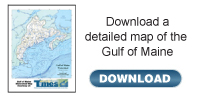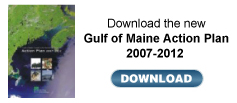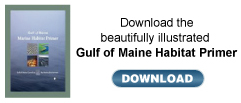Spiraling fuel costs, world financial woes inflict ‘perfect storm’ on GOM lobstermen
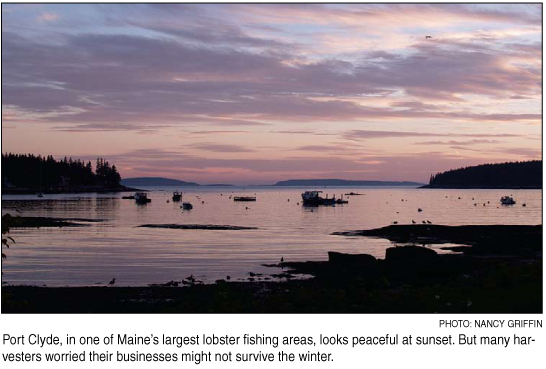
Lobstermen around the Gulf of Maine can usually predict to some degree the kind of economic season they’ll have by the number of lobsters they catch.
If their catches are high, their price may drop a little. If lobsters are scarce, prices are higher.
But this season, all the usual predictors were turned upside-down when harvesters faced what one Maine lobsterman described as “the perfect storm” of events affecting the industry — a combination of high fuel prices, the lowest prices for lobster in two decades, a global economic meltdown that lowered domestic and foreign demand, and plenty of lobsters.
“It’s a perfect storm,” said David Cousens, president of the Maine Lobstermen’s Association. “We’ve never seen anything like it before.”
Starting in May and June, diesel prices shot through the roof in concert with precedent-setting oil prices above $130 per barrel. Diesel quickly nudged its way upward above $4 (US) per gallon, more than twice the price of one year ago.
As the cost of oil increased, besides diesel fuel, each of the basic items lobstermen need rose in price — bait, plastic lobster totes, bait barrels and rubber bands.
Herring, the preferred bait of many Gulf of Maine lobstermen, nearly doubled in price. In the U.S. this was partly due to restrictions imposed by the New England Fisheries Management Council on mid-water trawlers fishing for herring from June to the end of September, meaning fewer pounds of herring available for bait.
The combination of scarcity and increased fuel costs led to a price of $40-$45 per tote (1.5 bushels), according to Robert Thompson, operations manager for the Spruce Head Fishermen’s Co-op in Spruce Head, Maine.
“It’s hard,” he said, “it’s going up every year.” A member of the co-op who did not wish his name used added, “In August I fished four days and brought in $1,200.54 worth of lobsters. My expenses were $1,200. And then I had to pay my sternman $200.”
Also due to rising fuel costs, the cost of salt to preserve the bait rose. Lobster prices failed to rise and then, in October, plummeted.
As the world’s financial systems retracted and stock markets tumbled, Canadian processors with lines of credit with Icelandic banks found those short-term credit sources closed to them.
As a consequence, the Barry Group, Ocean Choice International and Clearwater Fine Foods Inc., among others, stopped buying U.S. lobsters at the height of the fall season. Other markets for processed or frozen lobster, such as resorts, cruise ships, or restaurants, also cut back on their purchases as a result of the financial meltdown.
Cousens believes that with higher prices for all things related to oil, lobstermen are facing a hole from which they cannot climb out.
He argues it makes no sense in a time of rising expenses for Maine harvesters to fish hard in the summer months in the U.S. for a poor quality lobster that fetches a low price from the buyers.
“Shedders are a lousy product,” Cousens said of lobsters which recently molted and are usually caught in summer. “They are soft, they die easily. You get a high rate of shrinkage shipping them.”
Shrinkage refers to the pounds of lobsters that die while being stored or shipped.
“Set maybe fifty traps during the summer, to sell to the tourists,” he said. “Then go back to your normal trap limit in September and fish until December. Leave the lobsters on the bottom and then catch a good hard product next April.”
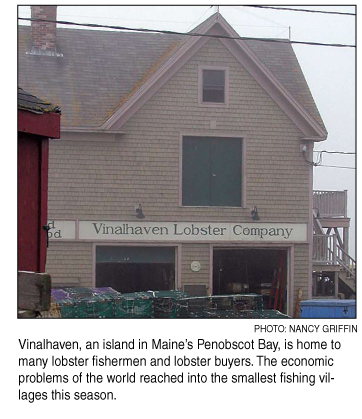 Many lobsters from Maine and Canada ship to Europe for Christmas sales. European consumers have long purchased environmentally-responsible products and a state-appointed Maine committee is investigating the possibility of certification from the Marine Stewardship Council (MSC) for the lobster industry. Many lobsters from Maine and Canada ship to Europe for Christmas sales. European consumers have long purchased environmentally-responsible products and a state-appointed Maine committee is investigating the possibility of certification from the Marine Stewardship Council (MSC) for the lobster industry.
In October, Maine’s governor called together a group of state financial agencies, banks and lobster industry representatives to try to figure how to help fishermen who may otherwise lose their businesses.
One Maine lobsterman said, “It’s not just ‘will you lose your boat?’ now, it’s ‘will you lose your bedroom?’”
Because the Canadian lobster fishery in Nova Scotia and New Brunswick operates under sequential seasonal openings with limits on the number of traps per lobsterman, the fishery is perhaps more efficient in its use of fuel and materials, but that fact doesn’t mean Canadian lobstermen were unaffected by spiraling fuel costs.
Nova Scotia lobsterman Wayne Spinney said harvesters in his lobster fishing area 34 spent an average of $17,000 (Canadian) during last year’s 6-month season, an unprecedented amount and nearly double the usual fuel expenditure for most boats.
While diesel fuel prices had dropped just before the start of the next 6-month season in late November, the combined economic problems warned of disaster.
“My buyer told me he’ll be done buying by December 20,” said Spinney. “Others are telling fishermen they might as well tie up after a week.”
While buyers in his area, north of Yarmouth, were not affected by the Icelandic bank crisis, local banks warned they wanted the lobsters to keep moving.
“No one’s holding right now,” said Spinney. His buyer told Spinney if he wanted a place to keep his lobsters, to use his facility. “But I can’t afford to hold lobsters. I’ve got bills.”
-- MW & NG
[ back to top ]
|






